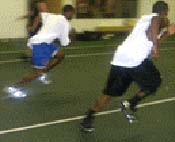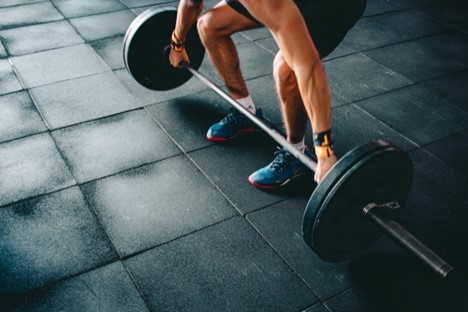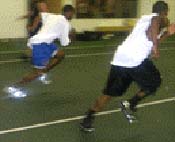 Matthew Diener is the PERFORMANCE TRAINING editor for Faith & Fitness Magazine. Look for regular articles in this department that focus on improving athletic ability and fitness level through new and exciting training methods. Our Performance Training department offers practical advice, innovative perspectives and the latest in support for athletes, parents, coaches, and all those striving to reach their highest physical potential.
Matthew Diener is the PERFORMANCE TRAINING editor for Faith & Fitness Magazine. Look for regular articles in this department that focus on improving athletic ability and fitness level through new and exciting training methods. Our Performance Training department offers practical advice, innovative perspectives and the latest in support for athletes, parents, coaches, and all those striving to reach their highest physical potential.
What does “in shape” mean to you?
Being able to walk a flight of stairs without gasping for breath? Maybe it is simply enduring thirty minutes on the treadmill. For some it may be finishing a mile run or a long hike.
Each person has unique and individual standards, expectations and goals for their physical fitness level. So, every athlete should view conditioning for their sport as unique, and everyone should develop specific conditioning strategies to achieve their individual fitness goals. It simply does not make sense to lump all athletes together, as each sport has its own specific demands and challenges. For instance, a football player would not train the same way as a cross-country runner. It just doesn’t make sense.
The idea of sport-specific conditioning has grown extremely popular over the past ten years. Coaches, parents, and athletes have started to realize that every sprint needs to have a purpose and every drill needs to be completed with a goal in mind. The body needs to be trained to utilize the correct energy systems needed for a particular sport. This lesson also rings true in our personal lives, as we should use the talents God has given us. This means we need to train our spiritual gifts, developing the strengths we are given to be a powerful witness to others in what we say and do. Paul writes in the Bible that we should run our race for eternal life in such a way as to win the prize. Our goal, then, is to stay focused on Him and use His strength to do great things.
THE THREE MAIN ENERGY SYSTEMS OF THE BODY
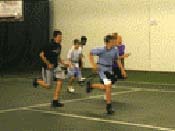 “Quick Energy” – The Creatine Phosphate System (ATP-PCr) – This system, which uses phosphagen to maintain ATP (energy) levels for energy, is the primary source for exercises performed at what is called maximal intensity – the maximum intensity level you exert during your exercise. It is used for short bursts of speed or power lasting up to approximately 10 seconds. Also known as the Phosphagen System, it is still used in activities lasting up to 30 seconds, although no longer the primary energy system. This is due to the fact that the Creatine Phosphate System does not use oxygen and therefore cannot sustain that intensity.
“Quick Energy” – The Creatine Phosphate System (ATP-PCr) – This system, which uses phosphagen to maintain ATP (energy) levels for energy, is the primary source for exercises performed at what is called maximal intensity – the maximum intensity level you exert during your exercise. It is used for short bursts of speed or power lasting up to approximately 10 seconds. Also known as the Phosphagen System, it is still used in activities lasting up to 30 seconds, although no longer the primary energy system. This is due to the fact that the Creatine Phosphate System does not use oxygen and therefore cannot sustain that intensity.
In your walk with Christ, sometimes you need a “burst” of energy to motivate and excite you to train your spiritual gifts. Try keeping a small cross or a card with a favorite Bible verse to refer to throughout the day. These small reminders can energize your spirit and keep that spark in your relationship with Jesus.
Which sports use this system?
One sport that uses the Creatine Phosphate System is football. Defined by short bursts of extreme power, aggression, and intensity, football demands that its athletes provide maximal effort every play, which is part of the reason so many people love the sport. However, football is not the only game in which quick and intense energy is needed. Sports such as soccer, lacrosse, baseball, softball, tennis, and field hockey all utilize the speed and power provided by the ATP-PCr System.
 “Pushing the Limits” – The Lactic Acid System – When an activity of fairly high intensity lasts longer than ten seconds, the Lactic Acid System is activated, helping the Creatine Phosphate System until it concedes after about thirty seconds. Unlike the ATP-PCr System, the Lactic Acid System uses glycogen stores in the muscle as the source of energy. This can occur with or without the presence of oxygen. Although the intensity reached during the first ten seconds cannot be kept, the Lactic Acid System allows an athlete to sustain moderate to high effort for a period of 2-3 minutes.
“Pushing the Limits” – The Lactic Acid System – When an activity of fairly high intensity lasts longer than ten seconds, the Lactic Acid System is activated, helping the Creatine Phosphate System until it concedes after about thirty seconds. Unlike the ATP-PCr System, the Lactic Acid System uses glycogen stores in the muscle as the source of energy. This can occur with or without the presence of oxygen. Although the intensity reached during the first ten seconds cannot be kept, the Lactic Acid System allows an athlete to sustain moderate to high effort for a period of 2-3 minutes.
Just as the lactic acid system can help push your threshold of high intensity training, you need to be in constant prayer so that God can push you to strengthen your faith. His challenges come in the form of Scripture. You talk to God through prayer, and He responds with His Word. So, when you pray, ask God to challenge you and deepen your understanding of His Will for your life as you read.
Which sports use this system?
Since the Phosphagen System supplies all the quick bursts and powerful movements, the Lactic Acid System is often seen as an afterthought. However, any athlete will tell you that they certainly feel the effects of this system, as lactic acid (the by-product of the Lactic Acid System) builds in the muscle during exercise, leaving quite a burning sensation. Basketball players are a primary user of this source of energy. At each end of the court, there are short, quick bursts and jumps followed by trips to the other end of the court. Although rests are present, stretches of continuous play can last anywhere from thirty seconds to ten minutes. Other sports who use this energy system constantly are hockey athletes, distance swimmers and track sprinters, especially 400m and 800m athletes.
“Good For the Long Haul” – The Aerobic System – For activities lasting more than 2-3 minutes, the Aerobic System supplies all the energy needed. Although this process takes longer than the previous two (using glucose from the muscle, liver, small intestine, and fatty acids for energy), the Aerobic System can supply ATP for energy for up to several hours at a low intensity.
What a great gift that God sent His Son and the race has already been won for you. Jesus endured every human trial and temptation so that you could live forever. So, your life should be one of rejoicing as a response to this incredible gift. In everything you do, praise God.
Which sports use this system?
The obvious answer here is distance athletes in sports such as track, cross country, and swimming. However, sports like field hockey, lacrosse, and soccer rely on this energy system as well. Think about it – a soccer player needs the endurance to last 90 minutes in many cases. However, they also need the ability to sprint, cut, and jump at any given time. This is possible due to the fact that ATP-PCr levels can be restored during aerobic exercise.
| Energy System | Intensity | Time | Sports |
| Creatine Phospate | High | 0-30 sec. | Football, Soccer, Baseball, Softball, Tennis, Field Hockey, Lacrosse |
| Lactic Acid | Moderate | 30 sec. – 3 min. | Basketball, Hockey, Swimming, Track |
| Aerobic | Low | 3 min. + | Distance Runners, Distance Swimmers, Soccer, Field Hockey, Lacrosse |
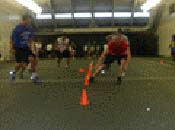 DESIGNING YOUR SPORT-SPECIFIC PROGRAM:
DESIGNING YOUR SPORT-SPECIFIC PROGRAM:
Interval Training: Vary Intensity and Maximize Results
The basic idea of interval training, or alternating bursts of high intensity exercise with light exercise or rest, is to build a higher capacity for cardiovascular training. This method is much more efficient for an athlete than a long, low intensity period of conditioning. The reason for this is that it builds strength in the heart muscle, helping more oxygen reach the muscles and also increasing the body’s tolerance for lactic acid build-up.
Designing Your Program
Before entering an interval-training program, it is best to prepare the body by engaging in moderate-to-high intensity cardiovascular workouts for at least two weeks. These workouts should involve sport-specific activity and should be completed 2-3 times/week.
Once you have a sound conditioning base, you can begin your interval training program. The first step in this process is to know the demands of your sport. If you play football, you should know that your work-to-rest ratio is around 1:5. Every play lasting 5-8 seconds is followed by a rest of between 30-40 seconds. So, your program will consist of short, but very intense bursts of speed and power with long rest periods between each repetition. However, it is important to note that some plays will call for an extended sprint or block downfield, so as your program progresses you will need to extend the length of each interval. Also, the possibility of no-huddle and 2-minute offenses calls for shorter rest periods later in your program so that you are prepared for this element of the game.
SAMPLE INTERVAL PROGRAM: PHOSPHAGEN SYSTEM
Day 1:
| Exercise | Rest | Repetitions |
| 10-Yard Sprint | 20 sec. | 5 |
| 20-Yard Sprint | 25 sec. | 4 |
| 30-Yard Sprint | 30 sec. | 3 |
| 40-Yard Sprint | 35 sec. | 2 |
| 50-Yard Sprint | 40 sec. | 1 |
| 40-Yard Sprint | 35 sec. | 2 |
| 30-Yard Sprint | 30 sec. | 3 |
| 20-Yard Sprint | 25 sec. | 4 |
| 10-Yard Sprint | 20 sec. | 5 |
Day 2:
| Sport/Position Specific Drill #1 (10 sec.) | 75 sec. | 4 |
| Sport/Position Specific Drill #2 (10 sec.) | 60 sec. | 4 |
| Sport/Position Specific Drill #3 (10 sec.) | 60 sec. | 4 |
*Please email Matt Diener using the information below for sport or position-specific drills. Drills should incorporate movements that would be used in a game situation.
If you play a sport such as basketball or hockey, your spurts of intense energy may last longer and require more of the lactic acid system. Your interval training program will have to incorporate longer periods of exercise with varying intensity and a work-to-rest ratio between 1:1 and 1:3. The main purpose will be to expand your threshold to maintain relatively high levels of intensity before having to decrease effort, as shifts may last longer than expected and penalties or fouls may be few and far between.
SAMPLE INTERVAL PROGRAM: LACTIC ACID SYSTEM
Day 1:
| 60-Yard Run (Jog 15/Sprint 15/Jog 15/Sprint 15) | 20 sec. | 6 |
| 80-Yard Run (Jog 20/Sprint 20/Jog 20/Sprint 20) | 25 sec. | 4 |
| 100-Yard Run (Jog 25/Sprint 25/Jog 25/Sprint 25) | 30 sec. | 2 |
Day 2:
|
Track Run (Sprint/Jog/Walk) |
Active |
9 Laps (18 Straight-aways: 6 Sprints/6 Jog/6 |
|
***All curves used for transition into next exercise, performed in sprint/jog/walk order*** |
||
Endurance athletes should never reach high intensity in their interval program. Reaching approximately 75% of your maximum effort is sufficient, with the active rest between 40% – 50%. Periods of moderate exercise should be sustained for at least 4-6 minutes with short periods of low intensity between each bout. Athletes in sports which rely on multiple energy systems equally such as soccer and lacrosse should balance days of high intensity training intervals with days of more endurance-based exercise. This will ensure that you will be able to utilize quick energy when needed, but will also be able to stay strong late in the contest.
SAMPLE INTERVAL PROGRAM: AEROBIC SYSTEM
Day 1:
| 3 minutes | 70% |
| 1 minute | 50% |
| 4 minutes | 70% |
| 2 minutes | 50% |
| 5 minutes | 70% |
| 3 minutes | 50% |
| 6 minutes | 70% |
| 4 minutes | 50% |
Day 2:
| 5 minutes | 60% |
| 2 minutes | 40% |
| 5 minutes | 75% |
| 2 minutes | 50% |
| 5 minutes | 60% |
| 2 minutes | 40% |
| 5 minutes | 75% |
| 2 minutes | 50% |
BRINGING IT ALL TOGETHER:
Just as there are ways to train your body for the specific demands of your sport, God puts opportunities in our lives to develop our skills for demonstrating Christ’s love among others. Below are a few examples of how you can train your skills and energize your faith.
If your gift is teaching…TEACH!
- First, grow in your knowledge of the Bible and the Christian lifestyle. Then offer to teach a church class or other faith-building gathering.
- Mentor a child at a nearby school or through an organization.
- Be open to your children, spouses, friends, and co-workers so that they know they can come to you for knowledge or advice.
If your gift is serving…SERVE!
- Help at a local community shelter in your free time.
- Volunteer to mow the lawn or clean an elderly neighbor’s house or even a church.
- Coach a recreation or school sports team as a chance to be a great role model for kids.
If your gift is leading…LEAD!
- Always have a cheerful heart and be kind to others.
- Live your faith! Do not be afraid to let others know of your faith and its role in your life by your words as well as your actions on a daily basis.
- Ask to serve and help provide guidance to a faith or community organization or youth group.
 Matthew Diener is a Certified Strength and Conditioning Specialist (CSCS) through the National Strength and Conditioning Association. He is currently training athletes as well as the general public in Maryland and northern Virginia. He can be reached at mdiener@sportandhealth.com
Matthew Diener is a Certified Strength and Conditioning Specialist (CSCS) through the National Strength and Conditioning Association. He is currently training athletes as well as the general public in Maryland and northern Virginia. He can be reached at mdiener@sportandhealth.com 
